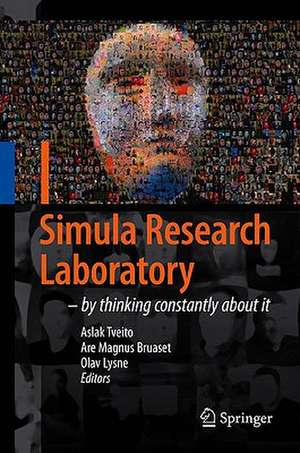Simula Research Laboratory: by Thinking Constantly about it
Editat de Aslak Tveito, Are Magnus Bruaset, Olav Lysneen Limba Engleză Hardback – 3 noi 2009
| Toate formatele și edițiile | Preț | Express |
|---|---|---|
| Paperback (1) | 658.55 lei 6-8 săpt. | |
| Springer Berlin, Heidelberg – 23 noi 2014 | 658.55 lei 6-8 săpt. | |
| Hardback (1) | 600.79 lei 38-44 zile | |
| Springer Berlin, Heidelberg – 3 noi 2009 | 600.79 lei 38-44 zile |
Preț: 600.79 lei
Preț vechi: 750.98 lei
-20% Nou
Puncte Express: 901
Preț estimativ în valută:
114.96€ • 120.35$ • 95.12£
114.96€ • 120.35$ • 95.12£
Carte tipărită la comandă
Livrare economică 01-07 aprilie
Preluare comenzi: 021 569.72.76
Specificații
ISBN-13: 9783642011559
ISBN-10: 3642011551
Pagini: 668
Ilustrații: X, 656 p.
Dimensiuni: 155 x 235 x 50 mm
Greutate: 1.07 kg
Ediția:2010
Editura: Springer Berlin, Heidelberg
Colecția Springer
Locul publicării:Berlin, Heidelberg, Germany
ISBN-10: 3642011551
Pagini: 668
Ilustrații: X, 656 p.
Dimensiuni: 155 x 235 x 50 mm
Greutate: 1.07 kg
Ediția:2010
Editura: Springer Berlin, Heidelberg
Colecția Springer
Locul publicării:Berlin, Heidelberg, Germany
Public țintă
ResearchCuprins
The Scene.- What Would you do if you Suddenly got an Annual Grant of About Ten Million Dollars?.- By Thinking Constantly About It.- The Simula Culture - How we do Research, Education and Innovation.- Impressed with Targeted Research Strategy.- The Hamming Experience.- Richard Hamming - You and Your Research.- Simula Research Laboratory — A Different Research Institution.- IT Fornebu and the Political Battle that led to the Creation of Simula.- The Right Step at the Right Time.- A Brief History of Norwegian Science and Research Policy.- Simula — The Language.- Basic Research.- to Basic Research.- Networks and Distributed Systems — Why, What, How and What’s Next.- Scalable Interconnection Networks.- Providing Resilience in Communications Networks.- From Gilgamesh to Star Wars.- RELAY — On the Performance and Resource Utilisation of Time-Dependent Large-Scale Distributed Systems.- Scientific Computing - Why, What, How and What's Next.- Catching the Beat.- Computer Simulations of the Heart.- A Message from the Heart.- Can ECG Recordings and Mathematics tell the Condition of Your Heart?.- Past and Future Perspectives on Scientific Software.- Software Engineering — Why, What, How and What’s Next.- A Matter of Judgement.- Software Development Effort Estimation — Demystifying and Improving Expert Estimation.- Faulty Until Proved Correct.- Software Verification — A Scalable, Model-Driven, Empirically Grounded Approach.- The industry is our lab — Organisation and Conduct of Empirical Studies in Software Engineering at Simula.- A Series of Controlled Experiments on Software Maintenance.- Research Education.- Educating Researchers — a Virtue of Necessity.- Thinking Outside the Box.- A Little Competition and a Lot of Cooperation.- Are you Planning to Take aPhD?.- An Extraordinary Investment.- Simula can do Much Better!.- Achieving Relevance.- Research Applications.- Bridging the Gap Between Industry and Research.- Making the Invisible Visible.- Turning Rocks into Knowledge.- A Tale of Three Start-ups.- Spinning Off from Simula.- We're Not a Telco, We're a Webco.
Recenzii
From the reviews:
“This book describes the philosophy behind Simula Research Laboratory, how we have tried to implement it, and the results that have come out of it. … Most of the book is intended for anyone interested in research, whereas some of the articles are written for experts interested in Simula’s research subjects.” (Zentralblatt MATH, Vol. 1181, 2010)
“This book describes the philosophy behind Simula Research Laboratory, how we have tried to implement it, and the results that have come out of it. … Most of the book is intended for anyone interested in research, whereas some of the articles are written for experts interested in Simula’s research subjects.” (Zentralblatt MATH, Vol. 1181, 2010)
Notă biografică
Aslak Tveito is managing director of the Simula group, and has worked at Simula Research Laboratory since the company was established in 2001. Tveito is professor in scientific computing at the Department of Informatics, University of Oslo. Prior to his appointment as managing director, Tveito served as research director for the scientific computing department at Simula. In addition to his work with the University of Oslo, Tveito has served as chief scientist at SINTEF Applied Mathematics.
Are Magnus Bruaset combines the position as Assistant Director of the Simula School of Research and Innovation AS with the leadership of Simula's industrial collaboration in computational geosciences. Bruaset is professor in scientific computing at the Department of Informatics, University of Oslo. Before he joined Simula, Bruaset served as senior research scientist at SINTEF Applied Mathematics, and as entrepreneur and vice president of R&D in the research-based company Numerical Objects AS.
Olav Lysne is director of basic research, and has worked at Simula since the establishment in 2001. During his tenure with Simula, Lysne has also served as head of the networks and distributed systems department and as research scientist. Lysne is professor in communication systems at the Department of Informatics at the University of Oslo where he has served in several capacities, including as founder and leader of a group in communication systems.
Are Magnus Bruaset combines the position as Assistant Director of the Simula School of Research and Innovation AS with the leadership of Simula's industrial collaboration in computational geosciences. Bruaset is professor in scientific computing at the Department of Informatics, University of Oslo. Before he joined Simula, Bruaset served as senior research scientist at SINTEF Applied Mathematics, and as entrepreneur and vice president of R&D in the research-based company Numerical Objects AS.
Olav Lysne is director of basic research, and has worked at Simula since the establishment in 2001. During his tenure with Simula, Lysne has also served as head of the networks and distributed systems department and as research scientist. Lysne is professor in communication systems at the Department of Informatics at the University of Oslo where he has served in several capacities, including as founder and leader of a group in communication systems.
Textul de pe ultima copertă
The Simula Research Laboratory, located just outside Oslo in Norway, is rightly famed as a highly successful research facility, despite being, at only eight years old, a very young institution. This fascinating book tells the history of Simula, detailing the culture and values that have been the guiding principles of the laboratory throughout its existence.
Dedicated to tackling scientific challenges of genuine social importance, the laboratory undertakes important research with long-term implications in networks, computing and software engineering, which includes offering a Centre of Excellence in biomedical computing.
The text covers every angle: the laboratory's background and political context, the work it has completed, its approach to the education and development of its researchers, and the organisation's efforts to promote the application of its research results. The key research projects and results are covered in separate chapters, each of which is preceded by a thumbnail description of the project and how the research is useful for society. As well as explanatory text, the other chapters feature interviews with major players in the facility's history, both inside Simula, among its collaborators, and in Norwegian society at large.
Dedicated to tackling scientific challenges of genuine social importance, the laboratory undertakes important research with long-term implications in networks, computing and software engineering, which includes offering a Centre of Excellence in biomedical computing.
The text covers every angle: the laboratory's background and political context, the work it has completed, its approach to the education and development of its researchers, and the organisation's efforts to promote the application of its research results. The key research projects and results are covered in separate chapters, each of which is preceded by a thumbnail description of the project and how the research is useful for society. As well as explanatory text, the other chapters feature interviews with major players in the facility's history, both inside Simula, among its collaborators, and in Norwegian society at large.
Caracteristici
Gives rare and valuable insights into the running of a successful research institute, which can serve as a model for other institutions Includes supplementary material: sn.pub/extras











